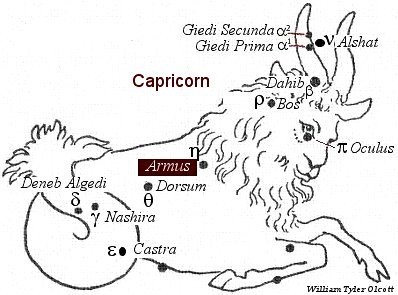
We all know that the Zodiac constellations were first charted by the Greek astronomer Ptolemy in the 2nd century. There are many constellations in the southern hemisphere. One such constellation is Capricornus. It is often related with Capricorn. However, Capricornus is a constellation whereas Capricorn is its sign. This can be clearly seen by the symbol it represents, which is ‘the goat’. One of the constellations of the zodiac, it lies in the southern hemisphere. No matter where you are worldwide, Capricornus climbs to its highest in the early September and is visible in the night sky. It belongs to the Zodiac family of constellations and represents a mythological creature that is half goat and half fish. Therefore, in Latin, it is also referred to as ‘horned male goat’ or ‘great horn’.
Some of the major stars in this constellation area are:
- Deneb Algedi: It is the brightest star in the constellation. The name is derived from an Arabic word ðanab al–jady meaning ‘the tail of the goat’. It is also known as Delta Capricorni. Located near the ecliptic, its luminosity is about 8.5 times than that of the sun. It has an apparent magnitude of about 2.85 and is approximately 39 light years distant.
- Dabih or Beta Capricorni: This is the second brightest star of this constellation. The name is derived from the Arabic word al–dhābiḥ meaning ‘the butcher’. Dabih is a star system located near the ecliptic and is approximately 328 light years distant. It consists of two components namely Dabih Major and Dabih Minor. Both of these are separated by 3.5 arcminutes and complete an orbit in every 700,000 years.
- Algiedi: It is an optical binary star. It derives its name from the Arabic word al–jady, meaning ‘the billy goat’. The two star systems of Prima Giedi (Alpha–2 Capricorni) and Secunda Giedi (Alpha–2 Capricorni) are separated from each other by 0.11 degrees in the sky.
- Nashira: This is a blue–white A–type giant star. The name is derived from the Arabic phrase which means ‘bearer of good news’. It is also known as Gamma Capricorni. It lies close to the ecliptic and its brightness varies by 0.03 magnitudes. Classified as an Alpha–2 Canum Venaticorum type variable, it is a chemically peculiar star with magnetic fields. With an apparent magnitude of about 3.69, the star is approximately 139 light years away from the earth.
- Yen or Zeta Capricorni: It is a double star consisting of a G–Type super giant and a white dwarf. Its brighter component that has an overabundance of praseodymium is a Barium star.it has an apparent magnitude of about 3.77 and is approximately 398 light years distant.
- Dorsum: A white A–type main sequence dwarf, the name Dorsum is derived from the Latin word for ‘the back (of the goat)’. With a magnitude of about 4.08, it lies approximately 158 light years away from the earth.
- Omega Capricorni: An M–type red giant, its traditional Arabic name is Baten Algiedi meaning ‘the belly of the goat’. It is a variable star that exhibits variations regularly in terms of its brightness and absolute magnitude. With an apparent magnitude of about 4.12, it lies about 630 light years distant from the earth.
Ψ Capricorni or Psi Capricorni: It is a yellow–white giant and has an apparent magnitude of about 4.15 and is approximately 47.9 light years distant.
It has one deep sky object, Messier 30 or NGC 7099. It is a globular cluster which is easily visible through a small telescope. It was one of the first deep sky objects that was discovered by Charles Messier in 1764. It is approximately 28,000 light years distant.
Seen at latitudes between +60° and -90°, it lies in the fourth quadrant of the southern hemisphere.
Capricornus occupies an area of 414 square degrees, making it the 40th biggest constellation in the sky. The furthest star Omega Capricorn is about 630 light years distant from the earth and hence, it can be said that Capricornus constellation is 630 light years away from the earth.
The origin of a story related to Capricornus dates back to the Bronze Age. Babylonians and Sumerians tribes first mentioned this constellation in 1000 BC, referring it to as MUL.SUHUR.MAS meaning the ‘goat fish’. Capricornus is also associated with Pan, the God of nature who had legs and horn of a goat. He was placed in the sky by Zeus as an appreciation to readily help other gods when in need. Pan had helped rescue the Gods during their war with the Titans. He would blow his conch shell to scare the Titans and on one occasion, warned the gods about a monster named Gaia. This monster was sent by the Titans to fight the gods; hence, Pan suggested the gods to disguise themselves as animals till the monster passed them. In the mean time, he jumped in river Nile and disguised half his body as a fish to distract Gaia. Zeus finally killed Gaia by his thunderbolts and since then, Capricornus has also been depicted as a goat with a tail similar to that of a fish. His son too was later recognized and was associated with an animal; he was represented as the Sagittarius constellation.

Capricornus neighbours constellations like Aquarius, Aquila, Microscopium, Piscis Austrinus and Sagittarius.


